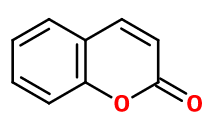Coumarin
Naturelle - Synthétique
Balsamic Ambery > Coumarinic

Crédits photo: ScenTree SAS
Other names :
Chromen-2-one ; Benzo-alpha-pyrone ; 2-oxo-1,2-benzopyran ; 1-benzopyran-2-one ; 1,2-benzopyrone ; Chromenone ; Coumarinic acid lactone ; Coumarinic anhydride ; Cumarin ; Ortho-hydroxycinnamic acid delta-lactone ; Ortho-hydroxycinnamic acid lactone ; 3-(2-hydroxyphenyl)-2-propenoic lactone ; Tonka bean camphor
Volatility :
Heart
Uses in perfumery :
Coumarin is a key element in the composition of oriental and fougere notes. Allows to bring a gourmand and vanillic facet to all types of accords. Good fixator.
Natural availability :
Coumarin is present in several plant extracts, including Tonka Bean Absolute, Hay Absolute or sweet woodruff, of which it is the major constituent and from which it can be extracted in its natural state.
Year of discovery :
Discovered in 1868. English chemist William Henry Perkin synthesized Coumarin for the first time, twenty years after its natural discovery by German chemist Friedrich Whöler. The industrial synthesis of Coumarin only started in 1877.
Other comments :
Coumarin is one of the 26 allergens in perfumery.
Its smell is similar to Dihydrocoumarin and less fruity than Octahydrocoumarin.
Its detection threshold is
Its smell is similar to Dihydrocoumarin and less fruity than Octahydrocoumarin.
Its detection threshold is
Price Range :
€
Stability :
Coumarin gets red in alkaline functional bases.

Crédits photo: ScenTree SAS
- Molecular formula :
- C9H6O2
- Molecular Weight :
- 146,14 g/mol
- Density :
- 1,247
- Flash Point :
- 162°C
- Fusion Point :
- 71°C
- Appearance :
- White solid
- Log P :
- Donnée indisponible,
- Boiling Point :
- 297°C
- Detection Threshold :
- Entre 34 et 50 ppb (0,000005%) selon les personnes et son seuil de reconnaissance est de l'ordre de 250 ppb
Synthesis route :
Coumarin is synthesized from Salicylaldehyde by a Perkin synthesis. This reaction consists in reacting Salicylaldehyde with acetic anhydride in the presence of sodium acetate at a high temperature. Acetic acid also results from this reaction and is the most used method.
Synthesis precursor :
Coumarin allows the synthesis of several perfume compounds. In a diluted alkaline medium, it can be hydrolysed to be converted to cis-2-Hydroxycinnamic acid. In a concentrated alkaline medium, at a hot temperature and in the presence of ethanol, the resulting product is trans-2-Hydroxycinnamic acid. Dihydrocoumarin is obtained by a catalytic hydrogenation of coumarin. Hydrogenation at a high temperature (392-482 °F) allows to synthesize Octahydrocoumarin.
Isomerism :
Coumarin does not have any isomer used in perfumery.
- EINECS number :
- 202-086-7
- FEMA number :
- Donnée indisponible.
- JECFA number :
- Donnée indisponible.
- FLAVIS number :
- Donnée indisponible.
- Allergens :
- Coumarin may provoke an allergic reaction on skin contact (redness, heat, scraching, prickling) for some people.
- IFRA :
- This ingredient is restricted by IFRA
- Restriction type :
- RESTRICTION
- Cause of restriction :
- DERMAL SENSITIZATION AND SYSTEMIC TOXICITY
- Amendment :
- 49
- Quantitative limit on the use :
-
Cat.1 Cat.2 Cat.3 Cat.4 Cat.5A Cat.5B Cat.5C Cat.5D Cat.6 0,089 % 0,08 % 0,089 % 1,5 % 0,38 % 0,11 % 0,16 % 0,035 % 0,0024 % Cat.7A Cat.7B Cat.8 Cat.9 Cat.10A Cat.10B Cat.11A Cat.11B Cat.12 0,18 % 0,18 % 0,035 % 0,52 % 0,52 % 1,6 % 0,035 % 0,035 % 33 % - Restriction type :
- RESTRICTION
- Cause of restriction :
- DERMAL SENSITIZATION AND SYSTEMIC TOXICITY
- Amendment :
- 49
- Comments :
- Tagetes erecta should not be used as a fragrance ingredient in any finished product application. Only Tagetes patula and Tagetes minuta should be used as fragrance ingredients according to the Restriction and Specification set in this Standard. This Standard is set due to the phototoxic effects of Tagetes oil and absolute. For more detailed information on the application of this Standard, please refer to the note on phototoxic ingredients in chapter 1 of the Guidance for the use of IFRA Standards. The restriction only applies to Tagetes patula and Tagetes minuta. The content of alpha-Terthienyl (Terthiophene, CAS number 1081-34-1) in Tagetes patula and Tagetes minuta oils and absolutes must not exceed 0.35.
- Quantitative usage limits :
-
Cat.1 Cat.2 Cat.3 Cat.4 Cat.5 Cat.6 Cat.7 Cat.8 Cat.9 Cat.10 Cat.11 0,089 % 0,08 % 0,089 % 1,5 % 0,38 % 0,0024 % 0,18 % 0,035 % 0,52 % 0,52 % 0,035 %
To learn more about IFRA's standards : https://ifrafragrance.org/safe-use/library
ScenTree is solely responsible for the information provided here.


